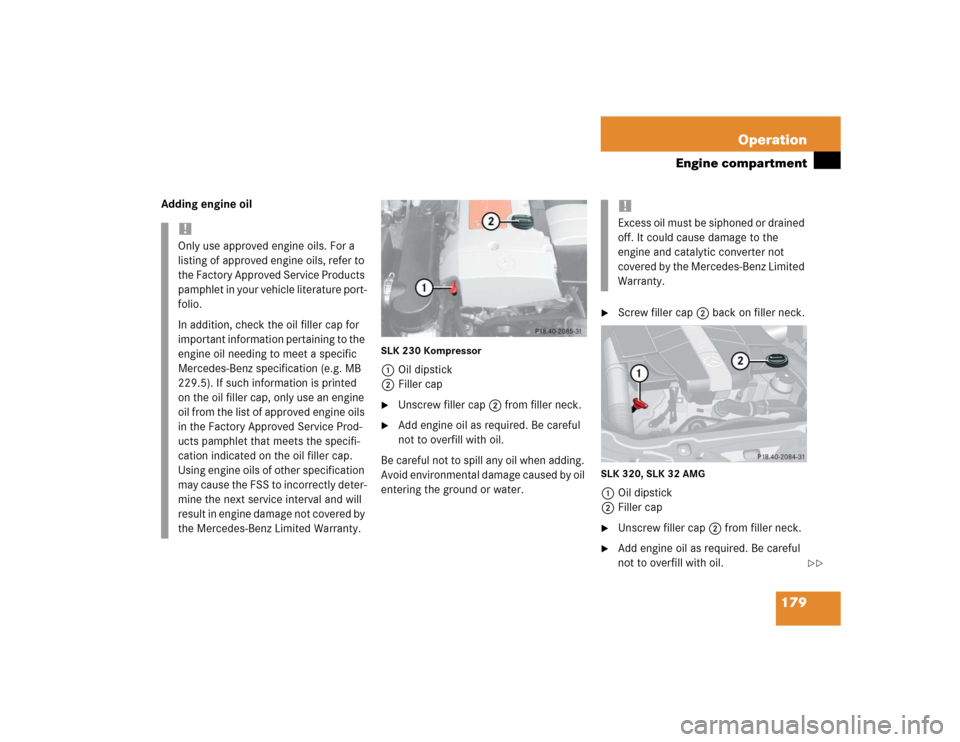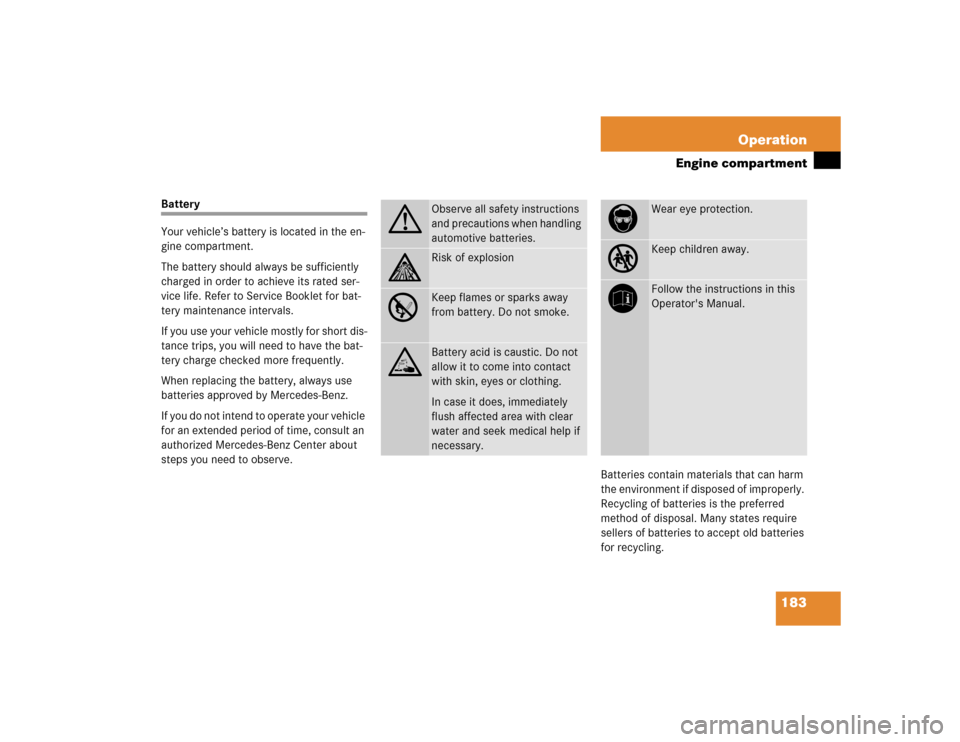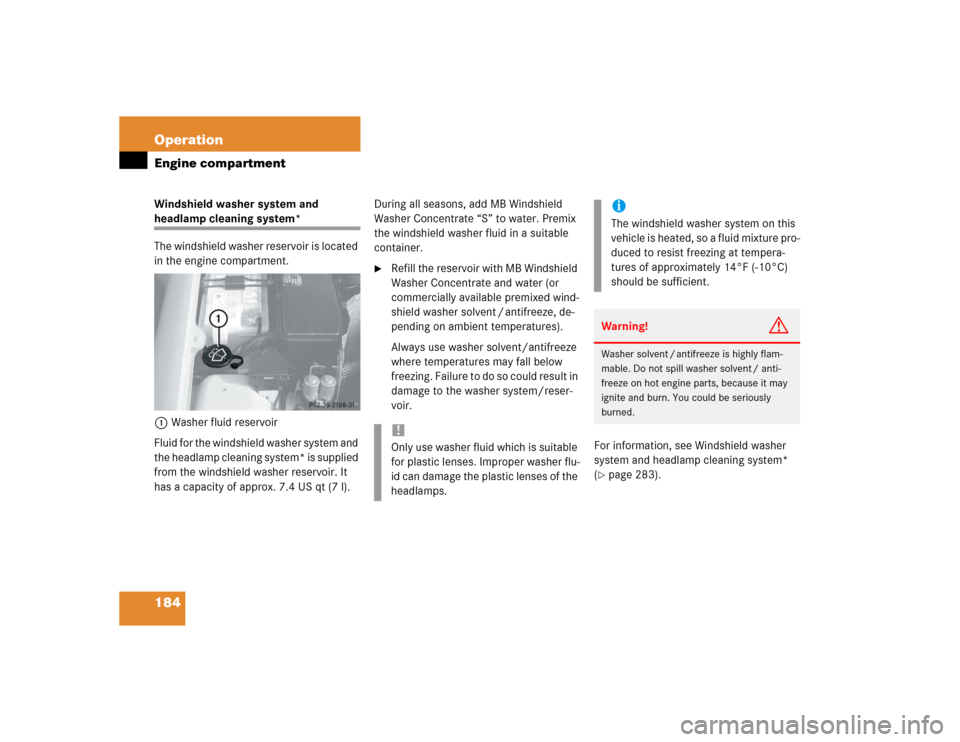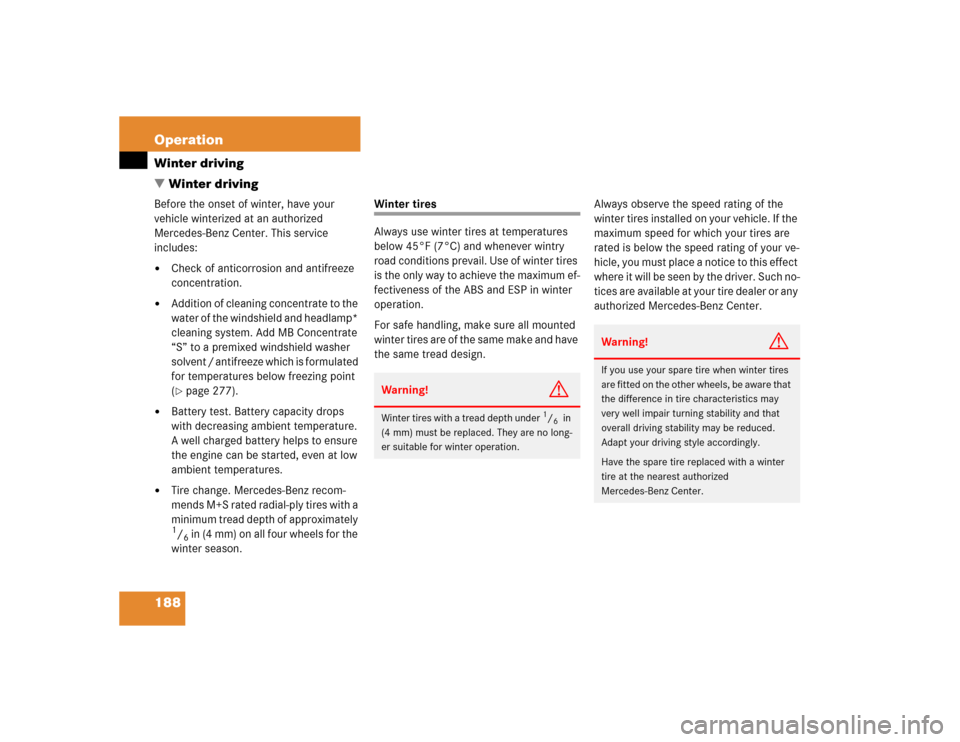Page 178 of 314
178 OperationEngine compartmentTo check the engine oil level with the oil
dipstick, do the following:�
Open the hood (
�page 174).
�
Pull out oil dipstick1 (
�page 179)
�
Wipe oil dipstick1 clean.
�
Fully insert oil dipstick1 into the
dipstick guide tube.
�
Pull out oil dipstick1 again after
approximately three seconds to obtain
accurate reading.
Oil dipstickThe oil level is correct when it is between
the lower (min) and upper (max) mark of
the oil dipstick.
�
If necessary, add engine oil.
For adding engine oil see (
�page 179).
More information on engine oil can be
found in the “Technical data” section
(
�page 277) and (
�page 279).
See the “Practical hints” section
(
�page 199) if the low engine oil level
warning lamp in the instrument cluster
comes on.
iThe filling quantity between the upper
and lower marks on the oil dipstick is
approximately 2.1 US qt. (2.0 l).
Page 179 of 314

179 Operation
Engine compartment
Adding engine oil
SLK 230 Kompressor1Oil dipstick
2Filler cap�
Unscrew filler cap2 from filler neck.
�
Add engine oil as required. Be careful
not to overfill with oil.
Be careful not to spill any oil when adding.
Avoid environmental damage caused by oil
entering the ground or water.
�
Screw filler cap2 back on filler neck.
SLK 320, SLK 32 AMG1Oil dipstick
2Filler cap�
Unscrew filler cap2 from filler neck.
�
Add engine oil as required. Be careful
not to overfill with oil.
!Only use approved engine oils. For a
listing of approved engine oils, refer to
the Factory Approved Service Products
pamphlet in your vehicle literature port-
folio.
In addition, check the oil filler cap for
important information pertaining to the
engine oil needing to meet a specific
Mercedes-Benz specification (e.g. MB
229.5). If such information is printed
on the oil filler cap, only use an engine
oil from the list of approved engine oils
in the Factory Approved Service Prod-
ucts pamphlet that meets the specifi-
cation indicated on the oil filler cap.
Using engine oils of other specification
may cause the FSS to incorrectly deter-
mine the next service interval and will
result in engine damage not covered by
the Mercedes-Benz Limited Warranty.
!Excess oil must be siphoned or drained
off. It could cause damage to the
engine and catalytic converter not
covered by the Mercedes-Benz Limited
Warranty.
��
Page 180 of 314

180 OperationEngine compartmentBe careful not to spill any oil when adding.
Avoid environmental damage caused by oil
entering the ground or water.�
Screw filler cap2 back on filler neck.
More information on engine oil can be
found in the “Technical data” section
(
�page 277) and (
�page 279).
Transmission fluid level
The transmission fluid level does not need
to be checked. If you notice transmission
fluid loss or gear shifting malfunctions,
have an authorized Mercedes-Benz Center
check the transmission.Coolant
The engine coolant is a mixture of water
and anticorrosion/antifreeze. To check
the coolant level, the vehicle must be
parked on level ground and the engine
must be cool.
The coolant expansion tank is located on
the passenger side of the engine compart-
ment.
!Excess oil must be siphoned or drained
off. It could cause damage to the
engine and catalytic converter not
covered by the Mercedes-Benz Limited
Warranty.
Warning!
G
In order to avoid any possibly serious burns:�
Use extreme caution when opening the
hood if there are any signs of steam or
coolant leaking from the cooling system,
or if the coolant temperature gauge indi-
cates that the coolant is overheated.
�
Do not remove pressure cap on coolant
reservoir if engine temperature is above
194°F (90°C). Allow engine to cool
down before removing cap. The coolant
reservoir contains hot fluid and is under
pressure.
�
Using a rag, slowly open the cap approx-
imately ½ turn to relieve excess pres-
sure. If opened immediately, scalding
hot fluid and steam will be blown out un-
der pressure.
�
Do not spill antifreeze on hot engine
parts. Antifreeze contains ethylene gly-
col which may burn if it comes into con-
tact with hot engine parts.
��
Page 181 of 314
181 Operation
Engine compartment
SLK 230 Kompressor1Coolant expansion tank
2Float in the filler neck�
Using a rag, turn the cap to the left to
the first detent position. Allow any ex-
cess pressure to escape.
�
Continue turning the cap to the left and
remove it.
The coolant level is correct if float2
can be seen at the top through the filler
neck.
�
Add coolant as required.
�
Turn the cap back, past the first detent
position, as far as it will go.
More information on coolant can be found
in the “Technical data” section
(
�page 281).
SLK 320, SLK 32 AMG1Coolant expansion tank
2Marker in the filler neck�
Using a rag, turn the cap slowly approx-
imately one half turn to the left to re-
lease any excess pressure.
�
Continue turning the cap to the left and
remove it.
iThe drain plugs for the cooling system
are located on the right side of the en-
gine block and at the bottom of the ra-
diator.
��
Page 182 of 314
182 OperationEngine compartment
The coolant level is correct if the level �
for cold coolant: the level must
reach marker2 in the filler neck of
the expansion tank.
�
for warm coolant: is approx. 0.6 in
(1.5 cm) higher
�
Add coolant as required.
�
Replace and tighten cap.More information on coolant can be found
in the “Technical data” section
(
�page 281).iThe drain plugs for the cooling system
are located on the right side of the en-
gine block and at the bottom of the ra-
diator.
��
Page 183 of 314

183 Operation
Engine compartment
Battery
Your vehicle’s battery is located in the en-
gine compartment.
The battery should always be sufficiently
charged in order to achieve its rated ser-
vice life. Refer to Service Booklet for bat-
tery maintenance intervals.
If you use your vehicle mostly for short dis-
tance trips, you will need to have the bat-
tery charge checked more frequently.
When replacing the battery, always use
batteries approved by Mercedes-Benz.
If you do not intend to operate your vehicle
for an extended period of time, consult an
authorized Mercedes-Benz Center about
steps you need to observe.
Batteries contain materials that can harm
the environment if disposed of improperly.
Recycling of batteries is the preferred
method of disposal. Many states require
sellers of batteries to accept old batteries
for recycling.
G
Observe all safety instructions
and precautions when handling
automotive batteries.
A
Risk of explosion
D
Keep flames or sparks away
from battery. Do not smoke.
B
Battery acid is caustic. Do not
allow it to come into contact
with skin, eyes or clothing.
In case it does, immediately
flush affected area with clear
water and seek medical help if
necessary.
E
Wear eye protection.
C
Keep children away.
F
Follow the instructions in this
Operator's Manual.
Page 184 of 314

184 OperationEngine compartmentWindshield washer system and headlamp cleaning system*
The windshield washer reservoir is located
in the engine compartment.
1Washer fluid reservoir
Fluid for the windshield washer system and
the headlamp cleaning system* is supplied
from the windshield washer reservoir. It
has a capacity of approx. 7.4 US qt (7 l).During all seasons, add MB Windshield
Washer Concentrate “S” to water. Premix
the windshield washer fluid in a suitable
container.
�
Refill the reservoir with MB Windshield
Washer Concentrate and water (or
commercially available premixed wind-
shield washer solvent / antifreeze, de-
pending on ambient temperatures).
Always use washer solvent/antifreeze
where temperatures may fall below
freezing. Failure to do so could result in
damage to the washer system/reser-
voir.
For information, see Windshield washer
system and headlamp cleaning system*
(
�page 283).
!Only use washer fluid which is suitable
for plastic lenses. Improper washer flu-
id can damage the plastic lenses of the
headlamps.
iThe windshield washer system on this
vehicle is heated, so a fluid mixture pro-
duced to resist freezing at tempera-
tures of approximately 14°F (-10°C)
should be sufficient.Warning!
G
Washer solvent / antifreeze is highly flam-
mable. Do not spill washer solvent / anti-
freeze on hot engine parts, because it may
ignite and burn. You could be seriously
burned.
Page 188 of 314

188 OperationWinter driving
�Winter drivingBefore the onset of winter, have your
vehicle winterized at an authorized
Mercedes-Benz Center. This service
includes:�
Check of anticorrosion and antifreeze
concentration.
�
Addition of cleaning concentrate to the
water of the windshield and headlamp*
cleaning system. Add MB Concentrate
“S” to a premixed windshield washer
solvent / antifreeze which is formulated
for temperatures below freezing point
(�page 277).
�
Battery test. Battery capacity drops
with decreasing ambient temperature.
A well charged battery helps to ensure
the engine can be started, even at low
ambient temperatures.
�
Tire change. Mercedes-Benz recom-
mends M+S rated radial-ply tires with a
minimum tread depth of approximately 1/6 in (4 mm) on all four wheels for the
winter season.
Winter tires
Always use winter tires at temperatures
below 45°F (7°C) and whenever wintry
road conditions prevail. Use of winter tires
is the only way to achieve the maximum ef-
fectiveness of the ABS and ESP in winter
operation.
For safe handling, make sure all mounted
winter tires are of the same make and have
the same tread design.Always observe the speed rating of the
winter tires installed on your vehicle. If the
maximum speed for which your tires are
rated is below the speed rating of your ve-
hicle, you must place a notice to this effect
where it will be seen by the driver. Such no-
tices are available at your tire dealer or any
authorized Mercedes-Benz Center.Warning!
G
Winter tires with a tread depth under
1/6 in
(4 mm) must be replaced. They are no long-
er suitable for winter operation.
Warning!
G
If you use your spare tire when winter tires
are fitted on the other wheels, be aware that
the difference in tire characteristics may
very well impair turning stability and that
overall driving stability may be reduced.
Adapt your driving style accordingly.
Have the spare tire replaced with a winter
tire at the nearest authorized
Mercedes-Benz Center.